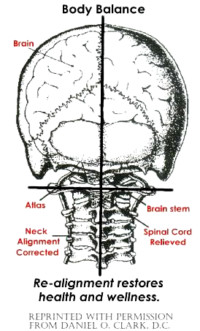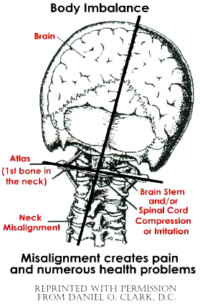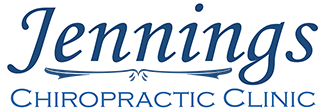Upper Cervical Specific Chiropractic is a natural health care system that creates more optimum body function by restoring Body Balance. A specialty within the Chiropractic field, the Upper Cervical procedure is a painless spinal correction, referred to as an adjustment. The adjustment restores body balance and reactivates the body’s natural healing ability.
What Is The Importance Of Body Balance?
Discovery
 Dr. Roger Sperry, Ph.D., won the Nobel Prize by discovering that 90% of the brain’s activity is used to balance your body within the gravitational field of earth. He stated that if your body is mechanically distorted, it begins to affect the other 10% of the brain’s activity, which controls all the other body functions such as breathing, digestion, or thinking.
Dr. Roger Sperry, Ph.D., won the Nobel Prize by discovering that 90% of the brain’s activity is used to balance your body within the gravitational field of earth. He stated that if your body is mechanically distorted, it begins to affect the other 10% of the brain’s activity, which controls all the other body functions such as breathing, digestion, or thinking.
Interference
If the body framework (bone structure and spine) is in an off-balanced or misaligned position, it can impede or block the electrical and chemical transmissions of the nervous system, which controls all of your body’s functions. This interference to the nervous system is called a vertebral subluxation. This alteration of nerve function can disrupt the body’s natural striving to maintain health.
Healing Cycle
Published research studies have shown that when body balance is restored, the body enters a healing cycle. When nerve system communication begins to normalize, the body can resume its natural path and striving for health. The healing cycle can look different for everyone. The healing cycle, among many things, elevates the immune system, increases blood and oxygen circulation and allows a deep sense of relaxation and comfort throughout the entire body. Simply put, a more optimum body performance is the result.
What Is An Upper Cervical Spinal Correction And How Does It Restore Body Balance And Remove Spinal Cord Compression?
The Upper Cervical spinal correction is a precisely calculated adjustment (correction) of the bone structure of the head and neck that is barely felt by the patient. The correction is designed to remove interference from around the brain stem. The brain stem is where the brain and spinal cord meet at the top of your neck. This area of the nervous system controls all of your body’s automatic functions, such as breathing, blood circulation, digestion and elimination, sexual activity, and posture. If the bone structure around the brain stem is misaligned and compressing that area, it creates postural distortion (body imbalance) and can negatively affect physical, emotional, and even mental performance.
The Upper Cervical spinal adjustment can balance the bone structure of the head and neck, removing interference around the brain stem, restoring body balance and reactivating the body’s natural healing ability. Therefore, the impact of the adjustment is far reaching. Many people mistakenly think the neck has little influence on how the entire the spine functions, let alone, the rest of the body.
How Is Body Balance And Spinal Cord Compression Determined?
 Body imbalance or postural distortion is determined by bilateral body weight difference, leg length disparity, visual inspection, and improper biomechanics.
Body imbalance or postural distortion is determined by bilateral body weight difference, leg length disparity, visual inspection, and improper biomechanics.
In a lying down or supine position, the leg lengths may differ as much as one inch. Postural measurement reveals head tilt, low shoulder, pelvic distortion, or improper spinal curvatures. Restricted neck movement or other decreased joint ranges of motion reveals improper body biomechanics.
X-rays to an Upper Cervical Chiropractor are like the blueprints for a contractor. Successfully achieving the desired results will be significantly improved when the ‘blueprints’ of your spine are used to help guide the process. Advancement in technology has made X-ray exposure and dosage very minimal. Without X-rays, we would be guessing about your health – which we will not do unnecessarily.
How Is The Upper Cervical Spinal Correction Calculated?
Once body imbalance has been determined, precise X-ray analysis, utilizing physics and mechanics, is used to calculate a correction formula. Each formula is calculated individually. No two spinal corrections are exactly alike. Once the formula has been calculated, the Upper Cervical spinal adjustment is utilized to re-align the bone structure of the head and neck, removing brain stem compression, and restoring body balance.
After the initial progress X-rays, further X-rays are usually unnecessary. The Upper Cervical X-ray system is set up to minimize X-ray exposure.
What Does The Upper Cervical Adjustment Feel Like?
The Upper Cervical spinal adjustment is painless and barely felt. Because of the precise X-ray analysis, an adjustment can be made without any forceful, jerking and twisting movements or any cracking and popping sounds.
It is safe for all ages. We have experience applying adjustments to all ages from 1 day to 95 years old.
 What Can I Expect After My First Upper Cervical Spinal Adjustment?
What Can I Expect After My First Upper Cervical Spinal Adjustment?
A variety of things may be noticed after being adjusted. These changes result from the body responding to the correction. In order to heal, the body goes through different cycles of repair.
These changes may be expressed as: tired and/or relaxed feeling, light headedness or possible headache, cold-like symptoms, muscle stiffness, discomfort in an area of an old injury, warmth and body elimination changes. Symptoms may decrease immediately or pain may move to another area of the body. Remember, these signs indicate the self-healing process is working.
Frequency of care decreases as body stabilization occurs.
Be sure to check out these videos about Upper Cervical Specific Chiropractic Care:
- What is Upper Cervical Care?
- The Nerve System Explained
- Brain to Body Communication
- What is a Subluxation?
- What is Body Imbalance?
- A New Approach to Health Care
- Holding Your Correction
- What About Surgery & Medicine?
- Why Haven’t | Head of This?
- Who Can This Help?
- Amazing Stories
- The Best Kept Secret in Health Care
- Visiting Your Upper Cervical Chiropractor
- Why Do I Need X-rays?
- After the First Correction
- How Long Will it Take to Get Better?
- What is Retracing?


